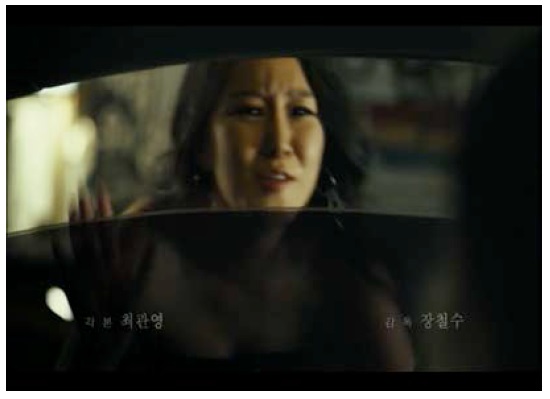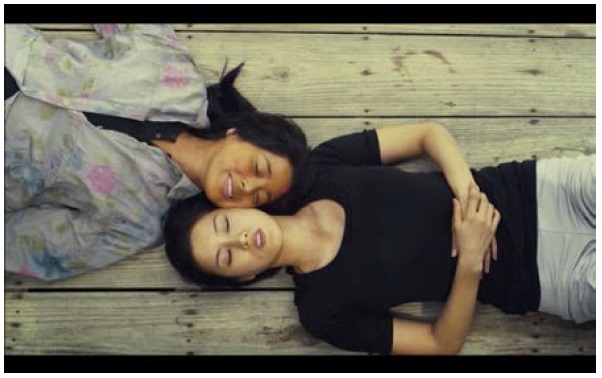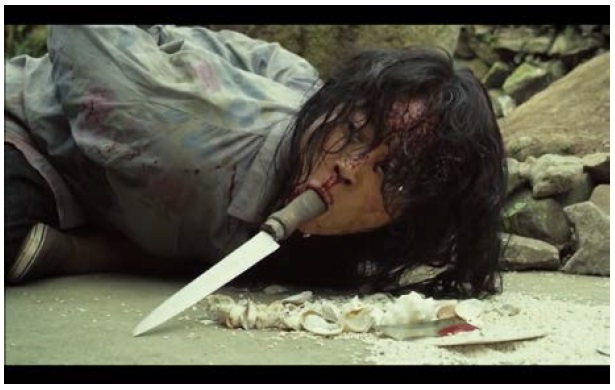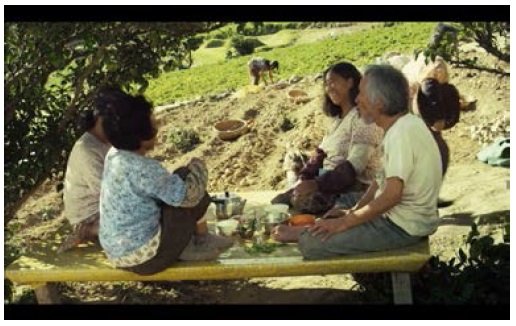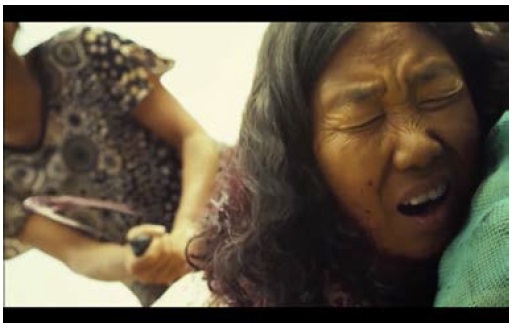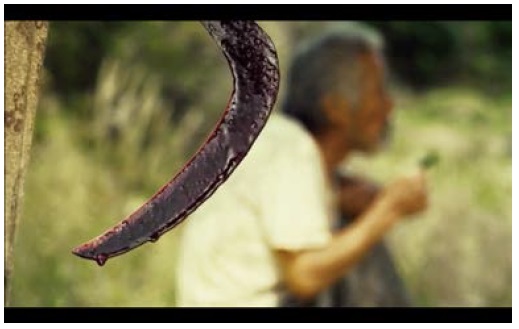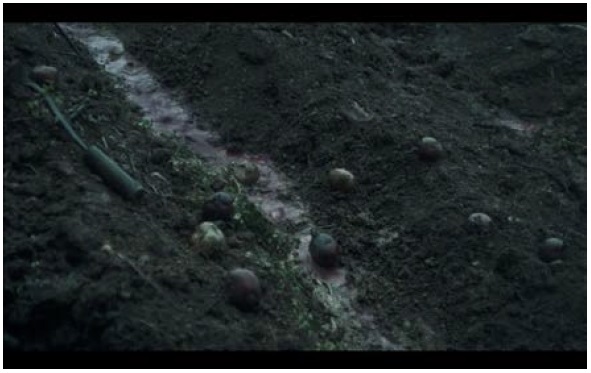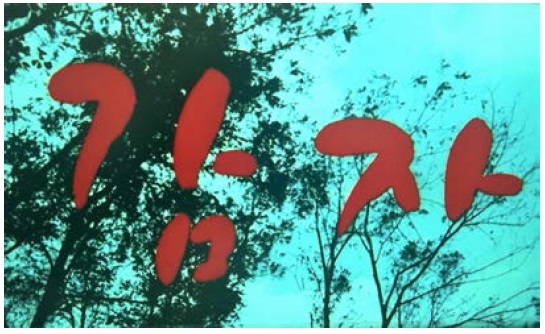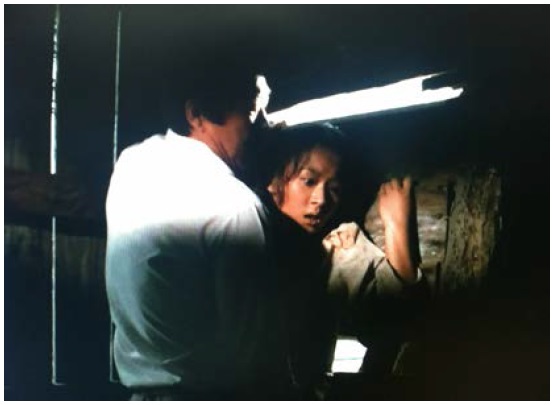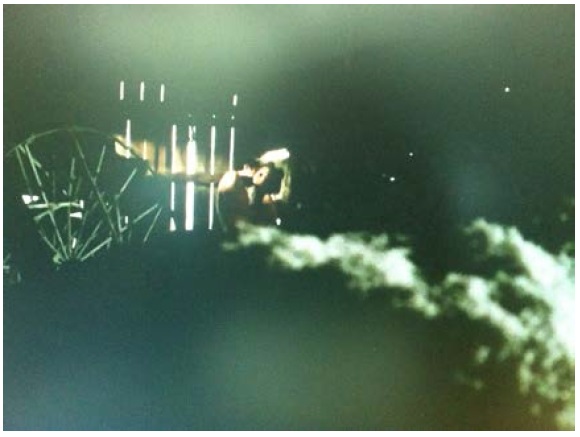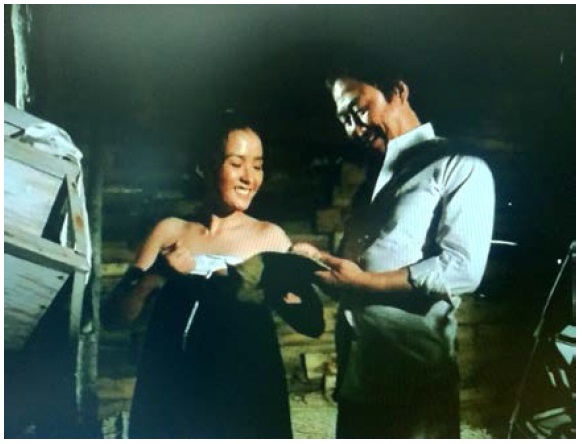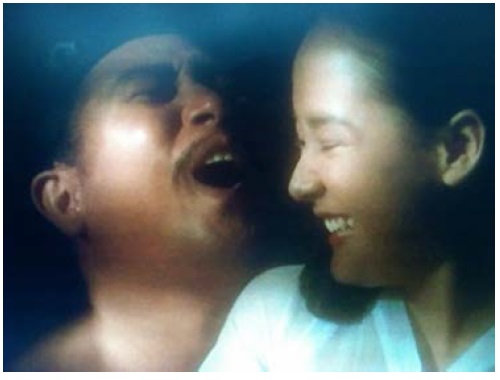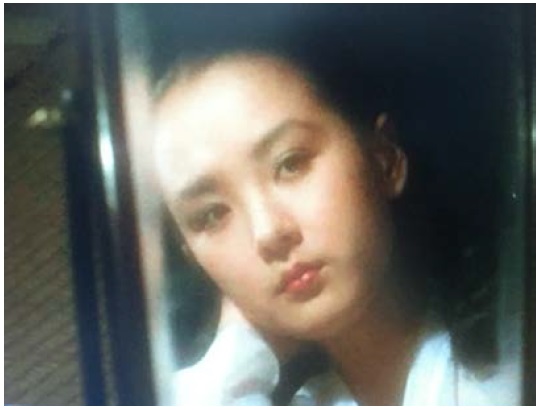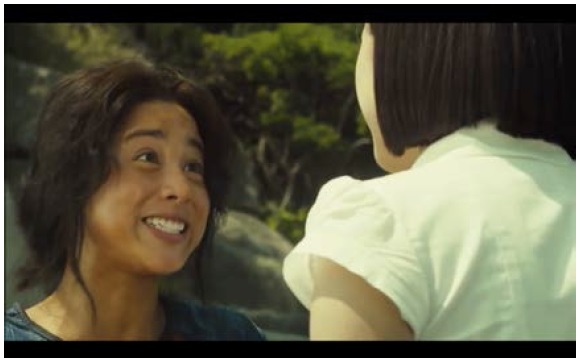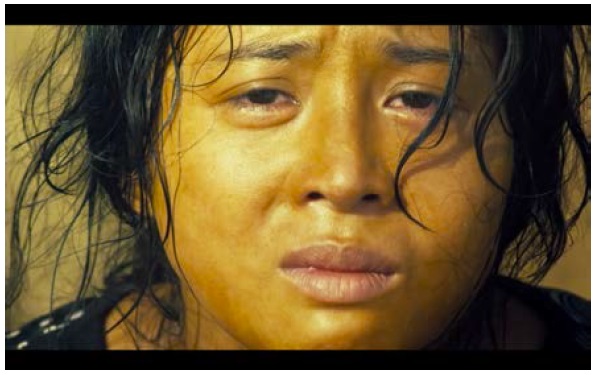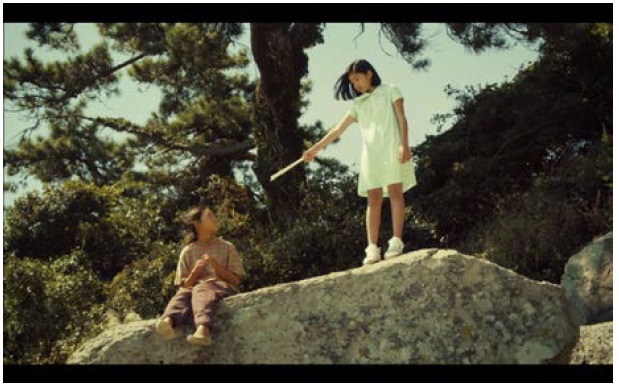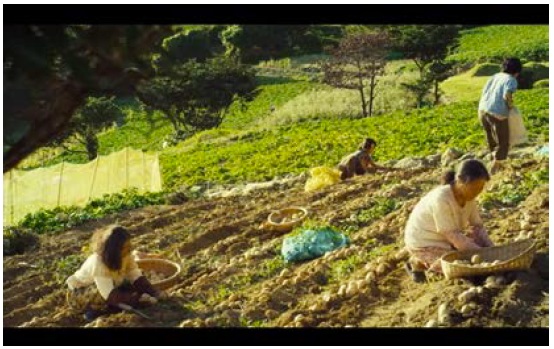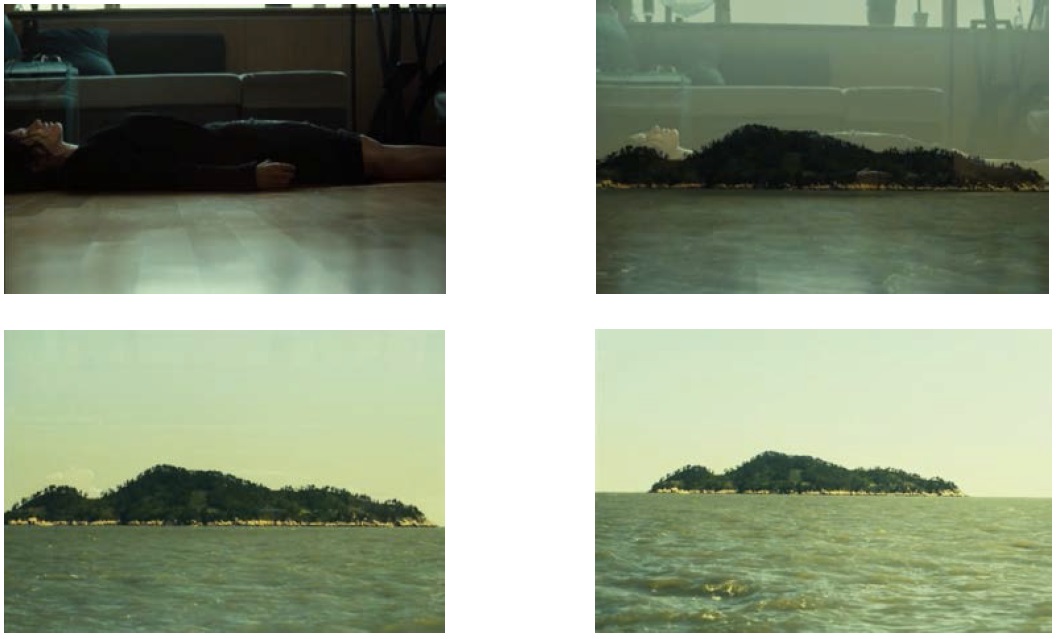Jang Chul-soo (Chang Ch’ŏl-su)’s directorial debut film Bedevilled (Kim Pong-nam sarinsakŏn ŭi chŏnmal, 2010) opens in a private car on the dark streets of Seoul. Successive shots of anonymous urban dwellers create the sense of a city viewed through a distanced, voyeuristic lens, as the car advances down the crowded streets. As a male announcer heard on the car radio tells listeners an amusing anecdote, the anonymous driver witnesses two thugs assaulting a young woman. Moving to medium-long shot, we see the woman try to flee the scene, pleading for help from the many others passing by, and coming into close-up again, banging on the window of the car. The driver responds by raising the dark tinted windows, as if closing an eye, as the radio announcers erupt into laughter. (Fig. 1)
Thus, we are introduced to Hae-wŏn, the cold, indifferent character who leads viewers into the revenge fantasy to come, and to the film’s investigation of the normalization of violence against women in contemporary South Korea. As the film unfolds, Hae-wŏn is a character with whom viewers negotiate a complicated relationship of identification and disidentification. Immediately following this night scene, the film moves to Hae-wŏn’s workplace, a bank, where she tersely refuses the emotional appeals of an elderly woman who is trying to borrow money to pay her apartment deposit. Later, when her younger female co-worker makes an exception to company policy and issues the old woman the loan, Hae-wŏn’s paranoia and gendered competitiveness lead to an outburst in which she strikes the younger woman. Hae-wŏn is thus characterized by either cruel in-difference or belligerence towards three women in rapid succession: the victim of the street assault, the elderly patron, and the younger female co-worker. The reasons for Hae-wŏn’s antipathy are not clearly spelled out by the film, but seem to stem from her fear of being associated with these vulnerable women, afraid of becoming a target of violence herself, and her unconscious affiliation with masculine dominance through cruelty. Jang’s film thus establishes gendered violence as a condition that afflicts all women, regardless of age or class, and South Korean society as one in which this violence is perpetrated across all sectors of society, even—or especially—by women themselves.
Worn down by her constant struggles in the sexist environments of urban Seoul, Hae-wŏn returns to Mu-do, the island home of her youth. After her outburst, she receives a work suspension, and travels to the island expecting to find respite from Seoul’s everyday violence and the loneliness of her city existence. Despite the island’s lush beauty and the expansive seascape, what Hae-wŏn encounters on the nearly depopulated island is a closed society of cretinous men and their enablers—older women—in a dynamic that degenerates into horrors far more extreme than the ones in Seoul she is trying to escape. Thus, on one hand, Bedevilled interrupts a nostalgic sensibility towards rural landscapes and the cliché of returning to one’s hometown to recover from the abuses of depersonalized city life. On the other hand, the film also complicates the now routine inversion of this ideal, whereby rural spaces and the people who inhabit them are psychotic, violent, and anti-social, a tendency that may be attributed to the fact that the young audiences of contemporary commercial cinemas in South Korea are often urbanites, with limited experience of rural lifestyles and landscapes except through media representation. While many of the island characters in Bedevilled do exhibit these negative traits—which have multiple literary and filmic genealogies, including the “urbanoia” conventions of the American slasher film, which I will be discussing later—the film cleverly critiques a recent trend in South Korean popular cinema that insists on a binary understanding of urban and rural settings.1 Against this fixed semiotic system, Bedevilled’s play with various genres and modes of representation simultaneously evokes dread and nostalgia for its natural landscapes, enveloping urban development and rural marginalization in a holistic critique of patriarchy’s chain of misogynist exploitation. The rural landscape in Bedevilled thus figures as a site of horrific beauty, unable to contain the sexual abuse and murderous violence that erupts out of its idyllic tableaux. Mu-do might be translated as “non-island,” as “mu” signifies negation; the ironic use of “Mu” as a proper noun renders Mu-do at once a designated site—Mu Island—and a nonexistent entity. As a non-place, in this sense, Mu-do is simultaneously dystopian and utopian.2
Hae-wŏn’s childhood friend, Pong-nam, welcomes her to Mu-do, marveling over her pale skin and refined city manners. In sharp contrast to Hae-wŏn, Pong-nam exudes goodwill, child-like curiosity, and an earnest desire for friendship and intimacy. These aspects of Pong-nam’s character become more remarkable as Hae-wŏn, the audience proxy, witnesses the miserable conditions of Pong-nam’s existence—the brutal physical, verbal, and sexual abuse she suffers from her husband Man-jong and his family. In addition to daily beatings she receives from her husband, Pong-nam’s brother-in-law Ch’ŏl-chong rapes her routinely and, even worse, the elders—her husband’s aunts—shame and dehumanize her, while keeping her enslaved as one of the few able-bodied laborers on the island.
Though Pong-nam is absolutely crucial to the community’s continuation, for she is the only young woman who remains on the island, she is not considered a full member of the community and leads a miserable, desperate existence. Thus, she pins her hopes on Hae-wŏn, to help her and her daughter escape the island. Pong-nam’s unstudied mannerisms trigger Hae-wŏn’s knee-jerk contempt for rural “backwardsness.” Hae-wŏn’s unsympathetic attitude makes Pong-nam’s blind faith in Hae-wŏn seem even more misplaced; we see later in the film that for months Hae-wŏn has been ignoring almost daily letters and phone-calls from Pong-nam, begging Hae-wŏn to take her daughter Yŏn-hŭi to Seoul, since she suspects that her husband is sexually abusing the child.
Throughout her time on the island, Hae-wŏn proves herself to be an unreliable confidante to Pong-nam. Moreover, Hae-wŏn’s mere presence upsets order and routine on Mu-do. Yŏn-hŭi, Pong-nam’s ten-year old daughter, shows troubling signs of absorbing the message that a woman’s value lies in her sexual desirability, so she does little to resist her stepfather’s inappropriate affections and even acts out jealously at Hae-wŏn and Mi-ran—a prostitute often called to the island to service Man-jong’s sexual urges—because she perceives them as new female competition. Pong-nam sees Yŏn-hŭi’s inevitable future in sexual enslavement on the island, and reveals her suspicions about Yŏn-hŭi and Man-jong’s relationship to Hae-wŏn in a last ditch attempt to persuade Hae-wŏn to help them. When Hae-wŏn responds to Pong-nam that she must be exaggerating or lying to gain sympathy, Pong-nam finally sees that Hae-wŏn has no intention of involving herself in Pong-nam’s situation and engineers a desperate escape attempt.3 Pong-nam enlists the help of Mi-ran a woman who is neither from Seoul nor from the island. Mi-ran’s lower class status, lack of stable family structure, and sexual victimization ground her solidarity with Pong-nam. However, the attempt is clearly futile, since limited access to the island means that the only boat that can be hired to carry the escapees belongs to a friend of Man-jong. Pong-nam’s daughter is killed in the conflict that arises when Man-jong comes to reclaim them. Soon afterwards, the film shifts its tone and genre and Pong-nam goes on a vengeful rampage, killing all of the island’s inhabitants.
1I am indebted to Jinsoo An, whose observations about this binary representation of rural space in recent films like Moss (Ikki, 2010, Dir. Kang Woo-suk [Kang U-suk]) and Bedevilled helped spur my investigation of a redefinition of pastoral fantasies via the reframing effects of genre mash-up. Kyu Hyun Kim has also helpfully pointed out other recent examples of variations on the “hillbilly” horror genre, including A Bloody Aria (Kut’a yubalcha tŭl, 2006) and To Catch a Virgin Ghost (Sasalli 2 km, 2004). 2In contrast to French anthropologist Marc Augé’s articulation of “non-places” in his Non-places: An Introduction to Supermodernity, trans. John Howe (London: Verso, 2009), I use the term to refer to Mu-do’s literal definition as “non-island.” Augé invokes the “non-place” to designate the spaces of transit and commerce that have become increasingly standardized across cultures and geographies, such as supermarkets, airports, hotels, and waiting rooms, that for him constitute the lived conditions of “supermodernity.” There might be some resonance in Augé’s concept of the “non-place” for my reading of Mu-do, if we take the alternatingly nostalgic and paranoid connotations of the rural as equally generic, transcultural, and pre-packaged signifiers that are symptomatic of contemporary postmodern (or “supermodern”) conditions. 3In an incisive and thoughtful review of the film, Kim Kyu Hyun suggests that Pong-nam’s blunt language—she uses the direct expression, “Man-jong is fucking Yŏn-hŭi,”—shocks Hae-wŏn and viewers’ sensibilities in such a way that Hae-wŏn cannot focus on the content of what is said, but gets caught up in its form; in this way, the film further expresses Hae-wŏn’s hypocrisy. See Kim’s review “Recent ‘Women’s Revenge’ Films and the Curious Case of Bedevilled on the website Modern Korean Cinema, during its featured “revenge week:” http://www.modernkoreancinema.com/ 2013/07/revenge-week-recent-womens-revenge.html
Though Bedevilled may seem at first glance to be part of a cycle of revenge films established by auteurs like Park Chan-wook (Pak Ch’an-uk) (Sympathy for Mr. Vengeance [Poksu nŭn naŭi kŏt, 2002]; Oldboy [Oldŭboi, 2003]; Lady Vengeance [Ch’injŏlhan Kŭmja-ssi, 2005]) and Kim Ji-woon (Kim Chi-un) (A Bittersweet Life [Talk’omhan insaeng, 2005]; I Saw the Devil [Angmarŭl poatta, 2010]) the film demands that we reconsider the ubiquity of revenge narratives in contemporary genre cinemas, and especially, their centrality in South Korean cinema of the last decade.4 Rather than citing the aesthetics and topoi of the auteurist South Korean revenge film, Bedevilled more fittingly signals the “rape-revenge film” as its generic frame of intelligibility. Appearing in multiple contexts including the Japanese pinku eiga of the late 1960s and 70s (e.g. Koji Wakamatsu’s Go Go Second Time Virgin), American B-films like I Spit on Your Grave (Meir Zarchi, 1978), mainstream Hollywood productions like Straw Dogs (Sam Peckinpah, 1971) and The Accused (Jonathan Kaplan, 1988), and auteurist art cinemas from what has been coined the “New French Extremism,” such as Gaspar Nöe’s Irreversible (2002), the rape-revenge film has been discussed in terms of its potential for gender critique through its presentation of rape as a crime punishable by death, its perverse circuits of identification, and its masochistic libidinal economies.5 On the other hand, however, the genre has been criticized for exploiting the image of the suffering female body as an opportunistic and cynical marketing strategy. Some rape-revenge scenarios gratuitously objectify women, denying them subjectivity, especially when a male hero deals out the punishment for the woman’s violation.6 Bedevilled targets precisely this tension in the genre, and uses a split protagonist structure as the crux of the film’s social critique, to render the woman both vengeful victim/spectacle and witness/ spectator. (Fig. 2)
Revenge is a classical driving force in popular narrative, and in both philological and psychological modes of narratology, revenge has primordial or regressive connotations. More specifically, revenge evokes the lex talionis, or the law of retributive justice, which transcends given or man-made law to deliver a judgment rooted in natural law, in which righting wrongs serves to restore the balance of the cosmos. This principle authorizes the pursuit of revenge, at all costs, and its celebration, no matter how violent, because of the logic of debt that subsumes the acts of both protagonist and antagonist. In the psycho-dynamic approach to revenge, the impulse towards retaliation—the projection of one’s suffering onto another in order to gain mastery over it—is mainly interpreted as a regression to infantile fears of a lack of control, traced to childhood trauma. Both discourses seem similar in criticizing the economy of revenge as a drain on value, yet also authorizing revenge as an “age-old,” primary human experience or be-havioral tendency.7
In revenge films, works that address both approaches to the economy of revenge are judged the most successful examples of the genre, including, as Steve Choe claims, the revenge tales of recent South Korean cinema.8 Of these films, Kyung Hyun Kim has noted their peculiar lack of interest in social institutions such as the law.9 These revenge narratives are generally appealing for their linearity, harnessing viewer identification with an individualized protagonist and outlining the circumstances that motivate the desire for vengeance. Although, in invoking the law of retributive justice, revenge narratives point to a generalized social dimension, in many cases, they reduce the collective to the social contract maintained by heroic, self-made men, as fantasized by a liberal ideology of possessive individualism. Bedevilled, in contrast, uses the revenge plot to facilitate the cinematic expression of trans-individual culpability. In other words, unlike the typical revenge narrative, which individualizes justice, Jang’s film uses the desire for revenge—its affective register of indignation—to indicate the deep structural conditions of violent sociality in South Korea. Moreover, by embedding its revenge plot in the affective and visual conventions of the slasher genre, Bedevilled interrupts the use of the revenge trope as a depoliticizing, privatizing system of generic representation, and foregrounds the social implications of cinema as an act of witnessing.
According to Carol Clover, in her seminal text Men, Women, and Chainsaws: Gender in the Modern Horror Film, the rape-revenge genre signals a forceful, if blunt, feminist stance against sexual violence. This can have the ancillary effect of arousing masochistic fantasies in male viewers who take pleasure in the spectacle of sexually charged retribution, for instance in I Spit on Your Grave, in which the female victim/protagonist, methodically eliminates four rapists after first sexually humiliating them.10 Clover compares this ethos with that of the slasher film; her reading of the American slasher genre, which has become widely cited in film genre studies as well as in fan discourse, focuses on the juvenile masculinity of the slasher film’s target audiences, and the ways in which the genre plays to their ambivalent desires and fears. Clover writes that from the early 1970s until the mid 80s, “the slasher was the ‘exploitation’ form of choice for junior horror fans…the majority audience, perhaps even more than the audience for horror in general, was largely young and male—conspicuously groups of boys who cheer the killer on as he assaults his victims, then reverse their sympathies to cheer the survivor on as she assaults the killer.”11Bedevilled engages with the slasher film canon in a rape-revenge narrative by activating the split identification that Clover cites in the slasher genre’s gendered reception—the flip between identification with the killer and the victim—by abruptly introducing the slasher genre’s blood-soaked spectacle of serial murder in its final third and adopting some of its conventional character types and landscapes.
One of the common elements of both the American slasher and rape-revenge films is a sensibility that Clover calls “urbanoia,” in which a character ventures from the city to the country and encounters there a landscape of under-development, populated by regressive, sinister figures who are handicapped by poverty and, in many cases, incestuous in-breeding. Bedevilled portrays the ambiguous cause of the island community’s decline as a natural disaster that kills off most of the male population and the matriarchal order that results. All of the older women on the island are “aunts,” to Pong-nam’s husband and brother-in-law, yet their paternal lineage ambiguously leads to a vacant and feeble male forebear, the island’s sole male elder. Where Bedevilled deviates from the urbanoia film is in its ambiguous depiction of urban society. Even though the city does not deal with the same challenges of in-breeding and lack of genetic diversity, it is not a positively drawn space that opposes the island. Indeed both the city and the country produce dangerous conditions for women, manifest in the constant threat of extreme violence and sexual predation. While the film could be said to present a cautious endorsement of the city in specifying it as an actual space—Seoul—in which, “kind people exist,” as Pong-nam incredulously remarks, and the law can function to mitigate violence and cruelty as long as citizens like Hae-wŏn do their part to address these ills, Mu-do, in contrast, is constructed entirely by generic codes and symbolic conventions, suggesting that it serves as a con-tainer—a scene of fantasy—for both positive and negative forms of idealization. Yet, Mu-do and Seoul are also isomorphic, with Mu-do presenting in microcosm the social relations that produce Seoul’s perilous environment, thus highlighting Mu-do’s “non-island” status in another register: Mu-do’s continuity with the mainland, in the legitimation of misogyny and patriarchal oppression, renders it not an island, but a sustaining node of a broader apparatus of cultural reproduction.
The film juxtaposes two distinct yet equally “extreme” forms of violence: the relentless and pervasive gendered violence (manifested across a spectrum of intensity from verbal abuse to rape) that establishes the strong desire for revenge and the spectacular, explosive violence of the psychopathic killer appropriate to the slasher-horror genre. In demanding a comparison of these two types of violence, the film suggests both their incommensurability and their co-implication, criticizing the visual pleasure of violent spectacle, while using the counterposed models of violence to overcome gender boundaries in audience identification. The film presents as hypocrisy any condemnation of slasher violence that excuses the gendered violence of the first two-thirds of the film. This is Hae-wŏn’s major failing, as she refuses to “see” that both forms of violence are equally extreme. For the viewer, on the other hand, the more genre-constrained slasher violence may register as a relief from the realist violence of rape and battery, while nevertheless inducing a strong affective response through the extremity of the slasher genre’s graphically depicted, grotesque bodily injury.
In a particularly complex invocation of the rape-revenge and slasher genres’ oscillating victim/perpetrator logics of identification, Pong-nam takes revenge upon her husband in a scene that explicitly engages the gendered dimensions of the slasher film. The shot sequence leading up to this scene presents a medium shot of Hae-wŏn running along a hilltop ridge after witnessing Pong-nam beheading Ch’ŏl-chong, a brief, long shot of Man-jong and the boat operator seen from Hae-wŏn’s point of view, and a scene of the two men in which Hae-wŏn shouts a warning to the men, just as Pong-nam is poised to attack them as they recoil in shock at discovering Ch’ŏl-chong’s severed head. Hae-wŏn’s choice to align with the men, despite what she has witnessed on the island and the numerous points at which she has emphatically refused to assist those in need, reveals her own deeply ingrained misogyny, which is shown to ground her ostensibly mainstream, bourgeois sensibilities. Hae-wŏn’s membership among the reprehensible islanders who victimize Pong-nam converges with her status as the surrogate for the audience or the figure of identification as the “final girl.” This duality in Hae-wŏn’s character function, I argue, urges spectator reflexivity.
Heeding Hae-wŏn’s warning, Man-jong overpowers Pong-nam and the scene cuts to the front yard of Man-jong’s house, the staging ground for Pong-nam’s most satisfying and graphic act of revenge. A canted view of spilled memorial offerings opens the scene, followed by a closeup of Pong-nam’s battered face as she groggily reminds herself to tend to Yŏn-hŭi’s funeral altar. Abruptly zooming out to a medium long shot, Man-jong kicks Pong-nam as she lies tied up on the ground and Hae-wŏn cringes in the foreground of the mise-en-scène. Man-jong squats, pulls Pong-nam up to face-level, and growls that she never showed him any affection, blaming Pong-nam for the failure of their union. In the citation of funeral memorial rites, a typical household ritual for demonstrating filial bonds, and in Man-jong’s oddly banal marital complaint, the scene juxtaposes domestic violence and slasher violence, uncannily suggesting their continuity through this defamiliarized family scene. As their domestic spat escalates Man-jong points a long, sharp blade at Pong-nam’s face, ranting that he should just take Hae-wŏn as his woman after he gets rid of Pong-nam, who has committed the unspeakable sin of killing his kin. Here, Man-jong switches roles with Pong-nam, as the murderous slasher brandishing the genre’s emblematic weapon, which abruptly revises Hae-wŏn’s attempt to “protect” social order. But rather than respond with the screams of the slasher victim, Pong-nam seduces Man-jong, licking the knife in a performance of mock fellatio. Man-jong becomes immediately aroused and drops the knife, as Pong-nam takes his finger into her mouth. Man-jong’s absurd distractibility and hyperactive sexual imagination liken him to Clover’s easily swayed, juvenile slasher spectator, leaving him open to attack again, when Pong-nam nearly severs his finger with her teeth in an act of symbolic castration. Pong-nam then takes the knife in her mouth, for her hands are still tied, and stabs Man-jong in the chest, reappropriating the phallic object with her mouth, the organ of seduction and, importantly, communication. (Fig. 3)
An earlier scene, which marks Bedevilled’s shift into the slasher modality is similarly structured by the juxtaposition of tropes of communalism and kinship with graphic slasher violence. As Pong-nam and her “aunts” harvest potatoes in the fields, the elders pause for rest. They sit together cheerfully, enjoying food and drink as a respite from the backbreaking work, and even begin singing “Arirang” in what is at once a clichéd reenactment of village sociality, idealized in nostalgic depictions of rural life, and a scene of utter cruelty towards Pong-nam. The visualization of Pong-nam’s transformation literally punctures the bucolic tableau, as Pong-nam matter of factly stabs the older women with her scythe (Figs. 4, 5, 6). As Pong-nam deflates the cliché of rural plenitude, the film dismantles the structural opposition between rural and urban subjectivity by questioning whether Pong-nam’s actions are a rational response to wrongs she has suffered, a result of being possessed or “bedeviled” as the English title suggests, or an expression of her low-status and uncivilized bestiality. All of these are presented as possibilities, according to thefilm’s articulation of genre elements and textual references. However, the film lands strongly on the side of justifying Pong-nam’s violence, for which the film also requires the viewer to take responsibility.
Though Bedevilled’s most important points of reference may not necessarily be American genre precedents, the film is indeed highly sensitive to the effects of cult spectatorship and the ways that popular genre cinemas circulate. As a festival winner and audience favorite at the 2010 Pucheon Fantastic Film Festival (PiFan), Jang’s film was situated and marketed as a genre tale, aimed at audiences with a taste for extreme genre spectacle, whether national or transnational. The fact of its unexpected success beyond the niche markets of genre spectatorship supports my claim that its mixing of genres serves a critical purpose, and moreover, that its intertextual relation to differing gendered modes of revenge narrative goes beyond mere citational remix.12 These modes include the masculinist revenge fantasy staged by South Korean action-revenge films, the feminist intervention of the rape-revenge genre, and the anti-normative, transgender identification at-tributed to the slasher film.13Bedevilled is also an intermedia text that hails a literary legacy transposed multiple times into film narrative. The film adapts two short stories by colonial period naturalist writer Kim Tong-in. Kim’s fiction similarly problematized fixed moral frameworks by portraying the impossibility of asserting a coherent ethical subject in the context of colonial modernity. Bedevilled cites “Potatoes” and “The Seaman’s Chant,” and brings together their narratives of decadent ruin and accidental misunderstanding leading to tragedy into a single, stinging critique of the naturalization of gendered violence in these stories (Fig. 7)
4The cycle of Korean masculinist revenge films has been analyzed with a focus on both moral and monetary debt—this is typically how revenge is interpreted, and in the context of the globalization of capitalist markets and an ambivalent attitude towards developmentalist ideology, questions of debt and repayment seem fruitful ones to pose, in attempting to read the films as indices of contemporary social anxieties. See in particular Joseph Jonghyun Jeon’s “Residual Selves: Trauma and Forgetting in Park Chan-wook’s Oldboy,” positions 17.3 (2009): 713–740. 5See “’Don’t Blame This on a Girl’: Female Rape-Revenge Films” by Peter Lehman in Screening the Male: Exploring Masculinities in Hollywood Cinema, edited by Steve Cohan and Ina Rae Hark (New York: Routledge, 1993), 103–117. 6For more on the “rape-revenge” scenario in Japanese new wave cinema, see “Cruel Stories of Youth” in David Desser’s Eros Plus Massacre: An Introduction to Japanese New Wave Cinema (Bloomington: Indiana University Press, 1988), 39–75; Chapter 5: “The Rape-Revenge Film: From Violation to Vengeance” in Colette Balmain’s Introduction to Japanese Horror Film (Ediburgh: University of Edinburgh Press, 2008), 93–112; and James R. Alexander, “The Maturity of a Film Genre in an Era of Relaxing Standards of Obscenity: Takashi Iishi’s Freeze Me as a Rape-Revenge Film,” Senses of Cinema (Issue 36, 2005). Accessed November 10, 2012. 7For a summary of these discourses of the function of vengeance in popular narrative and social relations, see Burkard Sievers and Rose Redding Mersky, “The Economy of Vengeance: Some Considerations on the Aetiology and Meaning of the Business of Revenge,” Human Relations 59.2 (Feb 2006): 241–259. 8See Steve Choe, “Love Your Enemies: Revenge and Forgiveness in Films by Park Chan-wook,” Korean Studies 33 (2009): 29–51. 9Of the South Korean auteurist revenge films of the 2000s, Kim writes, ‘‘vengeance is carefully restricted to the realm of the personal, never crossing over into the public domain: it is always aimed at other individuals and almost never against state institutions” in “’Tell the Kitchen That There’s Too Much Buchu in the Dumpling’: Reading Park Chan-wook’s ‘Unknowable’ Oldboy,” Korea Journal 46.1 (2006): 88. 10See Clover’s chapter “Getting Even” on the feminist critical potential of such cult films as I Spit on Your Grave. Men, Women, and Chainsaws: Gender in the Modern Horror Film (New Jersey: Princeton University Press, 1992) 114–165. 11Ibid., 23. 12Though Bedevilled was not a commercial success, garnering only about 160,000 admissions in its official national release (KOFIC data), it was a notable critical success for Jang and his cast, winning several awards domestically and internationally. Jang Chul Soo won the Best New Director Award at the 2010 Grand Bell Awards, the Korean Association of Film Critics Awards, and the Korean Film Awards. Internationally, Bedevilled swept several genre festivals, including the 2010 Fantastic Fest (Austin, Texas), the 2011 Fantasporto International Fantastic Film Festival (Porto, Portugal), and the 2011 Amsterdam Fantastic Film Festival. Beyond the specific genre festival context, Jang also won the 2010 AFI Fest New Auteur Award (Los Angeles, American Film Institute). See Bedevilled at imdb.com, kmdb.com, and http://koreanfilm.org/films2010.html#boxoffice. 13In “Discipline and Fun: Psycho and Postmodern Cinema.” Reinventing Film Studies. Ed. Christine Gledhill and Linda Williams. New York: Oxford University Press, 2000. 351–378, Linda Williams explains, “In her chapter on the contemporary ‘slasher film’ that forms the nucleus of her book, Clover notices how powerfully a masculine viewer casts his emotional lot with a ‘female-victim-hero’. This ‘final girl’, survivor of gruesome slice and dice mayhem, is, in her knife-wielding or chain-saw-wielding triumph at the end, anything but passive and not very feminine. Where traditional views of the horror genre have too simply polarized gender to active male monster and passive female victim, Clover’s analysis of the low exploitative subgenre of the slasher film discovers that a vicarious ‘abject terror, gendered feminine’ is crucial to the genre, and that this terror is merely the starting point of a roller-coaster ride that careens wildly, between the gendered poles of feminine abjection and masculine mastery.” (359)
Hae-wŏn leads us into the film narrative and, at first, seems to be the film’s protagonist. Soon, however, it becomes clear that Pong-nam (an ironic reference to Pong-nyŏ, the central character is Kim Tong-in’s “Potatoes”) is the focus of Bedevilled. The film’s seaside setting and story of a woman abused by two brothers evokes “The Seaman’s Chant,” particularly in a key scene in which Pong-nam’s violation by her brother-in-law actualizes an imagined sexual liaison between the wife and brother of the tale’s tragic boatman. Kim Tong-in has been interpreted as adapting the principles of naturalist literary realism to the Korean colonial context, foregrounding environment and fate in the lurid details of his characters’ decline. Bedevilled criticizes the fatalism of this approach to environment, suggesting that a collective maintenance of outmoded attitudes installs fatalism as an alibi for inaction.
Though Bedevilled repeats literary tropes from naturalist-realist literature ironically, such as the ruination of the fallen woman or the resignation of the failed patriarch, the film also continues to pose the questions raised by this literary tradition, particularly in the film’s disturbing visualization of patriarchal op-pression as pervasive social disease. By embedding tales that foreground the importance of environment in determining the fates of the characters in a revenge narrative that seems to underscore the importance of individualized agency, Bedevilled questions the literary texts’ moral framework, which allows the reader to attribute gendered violence to nature; at the same time, the film’s visceral quality and interest in the body is faithful to its literary heritage, which seeks to shake up comfortable, bourgeois attitudes towards the social realm by staging the impulses, drives, and primitive behavior of the marginal and dispossessed. In critiquing the apologetics of misogynist violence against women that one might read in Kim Tong-in’s stories, or, furthermore, in the history of Korean cinematic narrative, and in adapting Kim Tong-in’s literary texts as source material and bringing them into the “low-culture” space of the genre film, Bedevilled points to bourgeois culture’s complicity with structures of violence and exploitation in its enforcement (and enjoyment) of the arbitrary boundaries between high and low culture.14
In challenging this boundary, Bedevilled strongly critiques the legacy of the “literary film,” and its transposition as t’osok ero yŏnghwa, a cycle of films made during the 1980s that uses pre-modern settings to stage erotic spectacles for an assumed male audience. Many of the most commercially successful and inter-nationally recognized films of the Fifth Republic belong to this genre of “nativist erotic film” including domestic hits like Between the Knees (Murŭp kwa murŭp sai, Dir. Lee Jang-ho [Yi Chang-ho], 1984), Mulberry Leaves (Ppong, Dir. Lee Du-Yong [Yi Tu-yong], 1985), and Eo Udong (Ŏudong, Dir. Lee Jang-ho [Yi Chang-ho], 1985). As described by Eunsun Cho, international festival award winners by revered director Im Kwon-taek (Im Kwŏn-t’aek), “Surrogate Mother (Ssibaji, 1986), Adada (1988), and Sopyonje (Sŏp’yŏnje, 1993)—which won awards respectively at the Venice, Montreal, and Shanghai film festivals—and more recently Chunhyang (Ch’unhyangdyŏn, 2000), which was invited to compete in the 2000 Cannes festival,”15 also belong to this film cycle.16 According to Cho, these films are structured by three interlocking features: “premodern Korea as a historical setting, beautiful landscapes, and victimized women. Women are abused humiliated, abandoned, tortured, and sometimes killed in pristine natural settings. Absorbed into the beauty of the mise-en-scene, the suffering women are aestheticized and scarcely allowed to articulate their pain. When they die, they do so in coerced silence, their trouble-ridden bodies effaced.”17
Potatoes (Kamja, 1987, Dir. Byeon Chang-ho, Perf. Kang Su-yeon), adapted from Kim Tong-in’s short story, is a typical example of t’osok ero. Byeon’s version sets Pong-nyŏ’s rapid decline into prostitution, materialism, and psychosis against a backdrop of highly aestheticized rural landscapes. (Figs. 8–9) Moreover, the protagonist Pong-nyŏ is a character consistently presented in the visual vocabulary of erotic spectacle, particularly in the ways in which the film presents her reactions to the events that befall her. While conforming to the basic plot of Kim Tong-in’s story, Byeon’s film highlights Pong-nyŏ’s enjoyment of carnal pleasure, commodity consumption, and self-assertion through the manipulation of men by her sexual availability. In this way, Byeon’s film presents a male fantasy that places the responsibility for Pong-nyŏ’s fate not on patriarchal oppression but on her own avarice, and in the process cements the association between the feminine, the irrational, and the venal. (Figs.10–13). Although it is ostensibly a cautionary tale, Kamja affords its viewers the pleasure of viewing a passage from innocence to experience, creating a split between the stated message of Kim Tong-in’s morality tale and the voluptuousness of its erotic images and ravishing landscapes. The story of Pong-nyŏ’s decline is rigorously decontextualized, though in Kim’s source material, the passage from virtue to vice indicts poverty and fate as the main causes of her downfall. The ultimate culprit in the film version, however, is ironically that which is staged as the most satisfying source of visual pleasure: Pong-nyŏ’s growing appetite for power, sex, and material goods. Pong-nyŏ’s desire emerges most forcefully in relation to her sexual drive, and the film reflects this in multiple reaction shots that highlight Pong-nyŏ’s enjoyment, as she surrenders to what are figured as base, feminine impulses.
Bedevilled citation of this film and the steps it takes to undercut the representation of gendered decadence that Kamja offers as cinematic spectacle become clearer when comparing the two films’ presentation of their main characters’ reaction shots and their framing of landscape. In Kamja, the aestheticization of nature corresponds to the depiction of Pong-nyŏ’s primal nature—both sets of images similarly cater to easy consumption, reinforcing the analogy between femininity and landscape in their appeal as spectacle. Bedevilled, on the other hand, labors to produce dissonance in the depiction of the pre-modern island environment as both beautiful and horrible. Pong-nyŏ’s trans-formation in Kamja moves her from a hard-working, principled laborer, as she’s pictured working outdoors in the film’s early shots, to a vain, glamorous “modern” woman, who regards herself in a mirror and applies cosmetics. The latter image of Pong-nyŏ’s worldly state signifies both her “natural” decline and her rationalized self-concept as an instrument of male desire. (Fig. 14–15)
In contrast, Pong-nam’s transformation in Bedevilled corresponds not to her awakening of sexual desire and gendered subjectivity, but to her communion with nature and her desire for revenge. She greets Hae-wŏn at the beginning of the film with child-like curiosity, optimism, and warmth (Fig. 16). When she reaches her breaking point after the death of her child, close-ups of Pong-nam’s face refuse to aestheticize her suffering in a melodramatic mode. Rather than breaking down in grief and maternal devotion, Pong-nam’s transformation is undecidable: a descent into madness, an awakening to heightened awareness of injustice (which she has passively endured for most of the film), or an expression of nihilistic despair. Pong-nam’s transformation takes place in the field where she is put to work harvesting potatoes just days after Yŏn-hŭi has died and Hae-wŏn has betrayed her, when the latter claims not to have witnessed the circumstances of the girl’s death. Pong-nam’s unflinching stare at the sun brings her literal enlightenment, but this transformation does not rest upon vision as a source of knowledge. (Fig. 17)
Pong-nam’s passage from victim to avenger results from her disillusionment with Hae-wŏn, who refuses to aid in Pong-nam’s plight and lies to the provincial policeman who is called to the island to investigate the circumstances of Yŏn-hŭi’s death. Hae-wŏn’s refusal to use her vision to assist others is the opposite of Pong-nam’s gesture of tearing the scales from her eyes and unleashing the forces of retributive justice. Completely dispossessed, Pong-nam reacts as a subject divested of all social foundations and thus is forced to use the most primitive methods to right the wrongs against her. Bedevilled suggests, by contrast, that Hae-wŏn (like Pong-nyŏ in Kamja—we can identify the two women via their whitened skin and callous dismissal of the other women in their milieu) can appeal to other mechanisms of protection and recognition. Not only does Hae-wŏn have access to such protections, but she has class status, credibility, and mobility as a refined, urban subject. Thus, she learns, as the “final girl” of the slasher canon, that she has the moral obligation to survive those marginalized subjects, like Pong-nam, who do not have such recourse.
Hae-wŏn survives by killing Pong-nam, thus halting Bedevilled’s rape-revenge trajectory. While the incompleteness of Pong-nam’s revenge can register with some viewers as a violation of the revenge film’s promises, I argue that it serves as the basis of the film’s moral and political critique, refusing the simplistic, Manichean framework of the lex talionis as well as the shallow individualism of the slasher film’s “final girl” as the symbolic restoration of normative social structures. In flashback scenes from their youth, Pong-nam is shown to be Hae-wŏn’s protector; twice in the film’s present Pong-nam repeats this role, preventing Hae-wŏn’s rape by Ch’ŏl-chong as she lies in a drugged sleep, and violation by Man-jong in the scene of Pong-nam’s seduction/murder of her husband. Neither competence nor putative innocence shield Hae-wŏn from harm; rather, Pong-nam’s repeated self-sacrifice for Hae-wŏn render Hae-wŏn’s surivival morally ambiguous.
The instrument of Pong-nam’s death is a jagged, broken p’iri (oboe). In the childhood flashback scenes, Hae-wŏn tries with limited success to teach the rough and tomboyish Pong-nam how to play the p’iri. When a group of boys, including the young Man-jong and Ch’ŏl-chong, come upon the girls and begin to harass them, the p’iri becomes a weapon used by the boys to knock Pong-nam unconscious, as Hae-wŏn cowardly abandons her friend. The p’iri thus signals Hae-wŏn’s class difference from Pong-nam, as well as her indifferent betrayal, yet it also connects the women as a relic of their childhood friendship. When Hae-wŏn pierces Pong-nam’s jugular with the p’iri, she utters a terrified shriek, though not in anticipation of being stabbed as the slasher victim, but in recognition of her own identification with Pong-nam’s victimizers. Just as the boys used the p’iri to assault and sexually abuse Pong-nam, Hae-wŏn also violates Pong-nam, particularly by suppressing her ability to express her rage by externalizing the truths of what she has endured. As Pong-nam lies bleeding to death, Hae-wŏn cradles Pong-nam in her lap and plays her a song on the p’iri, an instrument of audible expression for Hae-wŏn but not for Pong-nam.
As Bedevilled transforms into a slasher revenge film, viewers’ identification returns to Hae-wŏn’s perspective. Like her, we are urged to take visual agency as an ethical injunction to critical awareness, particularly of the ways in which our visual pleasure is grounded in violence. Shots of the natural landscape reveal their sinister underside, so that we see that the beauty of the landscape emerges against signs of exploitation and inequality—whether class disparity, in the contrast between Hae-wŏn and Pong-nam’s experiences on Mu-do, or in the extraction of value from laboring bodies, in the images of Pong-nam’s exploitation by the island community (Figs. 18 and 20). Unlike these complex and contradictory images, which preserve and make visible social contradictions, Kamja’s landscapes are comfortably univocal, flattening subjects, land, and culture into unitary and airless aestheticized images (Figs. 19 and 21).
14Here I refer to the criticism of “extreme cinemas” as de-contextualized and apolitical commodities that trade in shock and novelty. Critiques of the aesthetics of the “extreme” in art-house cinemas claim that the hyper-violent aesthetics of discomfort operate as justification for cinematic exploitation. In a now infamous screed against the “New French Extremism,” published in Art Forum in 2004, James Quandt writes against what he perceives as “an international vogue for ‘porno chic,’ widely apparent in art-house films from Austria to Korea.” “Flesh and Blood: Sex and Violence in Recent French Cinema,” Reprinted in The New Extremism in Cinema: From France to Europe, eds. Tanya Horeck and Tina Kendall (Edinburgh: Edinburgh University Press, 2011): 24-25. My position on this question is complicated; like Clover, Williams, and other feminist theorists of body genres, I see a potential for critique as well as exploitation in the articulation of corporeal affect onscreen. However, I am also skeptical of the attempt to posit extreme violence as an index of the “real” or as having aesthetic value as such, especially in works that make use of particularly gendered and sexed bodies to make these appeals. 15Eunsun Cho, “The Female Body and Enunciation in Adada and Surrogate Mother,” Im Kwon Taek: The Making of a National Cinema, eds. David James and Kyung Hyun Kim (Detroit: Wayne State University Press, 2002) 85. In the same volume, Choi Chungmoo reads Sopyonje as staging an in-cestuous relationship between Songhwa, the suffering female body at the center of the film’s preservation of national culture through p’ansori, and Yubong, her p’ansori master and adoptive father. Viewers unfamiliar with the t’osok ero genre find Choi’s reading far-fetched and militant in its feminist stance, however, I would argue that Im’s filmography and the prevalence of t’osok ero in the years leading up to Sopyonje’s 1993 release lend support to Choi’s analysis. See Chungmoo Choi, “The Politics of Gender, Aestheticism, and Cultural Nationalism in Sopyonje and The Genealogy,” 107–133. 16I would argue that Im’s Chihwaseon (Ch’wihwasŏn, 2002), another success on the international film festival circuit, also owes to this tradition of nativist spectacle, though the film focuses on a male character. In this context, Lee J-Yong’s Untold Scandal (Sŭk’aendŭl - Chosŏn namnyŏ sang’yŏlchisa, 2003), which adapts Pierre Choderlos de Laclos’s eighteenth century novel Les Liaisons Dangereuses to the Chosŏn dynasty might be read as a complex translational gesture, in bringing the critique of the French Ancien Regime’s decadence into dialogue with the excesses of the waning years of feudal Chosŏn. 17Cho, 85–86.
At the end of Bedevilled, after Hae-wŏn has narrowly escaped Pong-nam’s vengeful fury, she returns to the city and to the police station, where she identifies the perpetrators of the assault that opens the film. She is a stand-in for the viewer, but she also presents an image of the larger social body. Presenting a continuous rather than opposed relationship between urban and rural malaise, the film’s literary and cinematic representations of social anomie propose an unexpected rewriting of the analogy between the female body and the land (or the parallelism between the fecundity of the woman and “mother earth”). In a stunning closing shot, Hae-wŏn, the woman from Seoul who’s returned to her urban context after a harrowing experience on the island, lies exhausted on the floor of her apartment, and her body poetically transforms into a long shot of the island. (Fig. 22) Rather than reinforcing the figuration of the feminine form with the reproduction of familial nationalism, the film negates this association, by superimposing the now depopulated island on the spent, abjected body of the contemporary female subject. The decline of the island society is presented as both “natural,” resulting from inbreeding, and social, in the decline of rural spaces caused by the leeching of resources to the city. However, Hae-wŏn is presented as the ultimate product of this naturalist decline—the decadence of her lack of awareness of interconnection. Hae-wŏn’s unwillingness to use her vision and her voice—her witnessing capacity—to help Pong-nam implicates the generations of film viewers who have similarly witnessed the exploitation of female bodies onscreen, for instance in the 1987 adaptation of “Potatoes,” in critically acclaimed examples of the “New Korean Cinema,” such as Im Kwon-taek’s Sopyonje or Jang Sun-woo’s Kkonnip, and in the films that made Jang Chul-soo’s mentor, Kim Ki-duk (Kim Ki-dŏk), a famous representative of film artistry in South Korea.18 In literalizing the lex talionis as “an eye for an eye,” Bedevilled takes revenge on the patriarchal lineage of Korean film and literary sensibilities, to balance the visual register of the suffering female body with an image of her fury.
Bedevilled thus criticizes the kinds of image repertoires that undergird main-stream cultural politics by mobilizing incommensurable genre frameworks—the individualized, revenge action film, based on the principle of retributive justice, the gender critique and/or exploitation of the rape-revenge film, and the social determinism of naturalist literature—to reorient the drive of social critique towards a collective identification. This group identity refuses to shore up an authoritarian, misogynist patriarchal order in the name of heroism, nationalism, or cultural essentialism.
18Jang himself credits his apprenticeship with Kim Ki-duk as helping him to develop his visual sensibilities. As suggested by one of the reviewers of this essay, Bedevilled can be said to reference Kim’s The Isle (Sŏm, 2003) and The Bow (Hwal, 2005). In particular, The Isle also closes with a poetic shot of a natural setting transforming into a woman’s body, itself an intertextual reference to John Everett Millais’s famous nineteenth-century painting of Ophelia. Ophelia, Shakespeare’s character-ization of femininity trapped between madness and paternal injunction, is an apt figure for both Hae-wŏn and Pong-nam; all of these women drown under patriarchal constraint.



